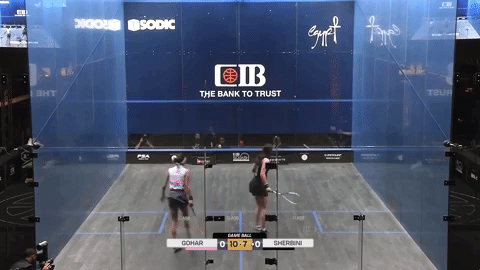Six and counting
Nour El Sherbini came from behind against Nouran Gohar to lift her 6th World Championship.
How did she do it? Here are some data-driven takes from Cairo.
Gohar started the match at a blistering tempo, pressing high and hitting hard.
Footage from SquashTV
Where Sherbini often let the ball come off the back wall, Gohar intercepted early:
Sherbini used the rebound every 3 shots (32%). Gohar did so just every 5 shots (21%).
Footage from SquashTV
This high press is seen also in the number of shots each player hit from mid-court.
In Games 1 and 2, Gohar hit ~35% of her shots from mid-court, compared with Sherbini’s ~25%
Gohar (blue) hit frequently from mid-court to start the match
Gohar took up a high T position, constantly looking to intercept early…
Footage from SquashTV
…and returned the ball with pace to the back of the court.
Over the match, Gohar hit 80% of mid-court forehands to deep (Sherbini 67%).
Percentage of shots played to each region from mid-right (circled)
It is no surprise then, that Gohar generally hits half of her winners from mid-court
The Terminator hits over half her winners from mid-court
Short, sharp rallies, lasting just 10 shots, and Gohar was in her element. She got off to a flyer, leading 1-0 and 6-4.
Then Sherbini turned it around. How?
Mean really length increased from 10.8 shots (Game 1) to 14.4 shots (Game 4)
One way to combat Gohar’s tempo is to lift out of trouble.
Throughout the match, Sherbini lifted 1 in every 7 shots (14%) - Gohar every 11 shots (9%), a tactic highlighted by Lisa Aitken and Joey Barrington on comms.
Footage from SquashTV
And this appeared a conscious tactical shift by Sherbini before the start of Game 2.
She went from slowing the rally tempo every 12 shots (Game 1) to every 6 shots (Game 2).
El Sherbini (yellow) lifted the ball twice as often in Game 2 as she did in Game 1
Add to this immaculate tightness…
Footage from SquashTV
…and hold in the backswing for deception and to break Gohar’s rhythm…
Footage from SquashTV
and Gohar at times lost her typically impeccable timing
Footage from SquashTV
Even with a bouncy ball, Sherbini’s touch and control pushed Gohar further into the corners, limiting the number of shots Gohar hit from the lethal mid-court:
In G3 and G4, Gohar hit from mid-court once every 4 or 5 shots, compared with once every 3 at the start of the match.
Late on, Gohar was unable to hit from mid-court with the frequency of the initial stages
But Sherbini is known equally for her attacking - and as the match drew on, this element of her game clicked into place.
Where initially Sherbini couldn’t find her range when attacking from deep (she hit 4 Unforced Errors in Game 1 to Gohar’s 1)...
Footage from SquashTV
…she started nailing her trademark drops from deep
Over the match, Sherbini hit 6 straight drop winners to Gohar’s 3
Footage from SquashTV
Priced into Sherbini’s tactics is a high-risk high-reward strategy: she typically hits 1 more Winner and 1 more Error per Game than Gohar. A pattern which played out on Sunday as well: Sherbini hit half her winners from deep, and two-thirds of her errors from deep…
El Sherbini hit most of her winners and errors from deep positions
…and hit more of both than Gohar.
El Sherbini hit 13 Unforced Errors, but 16 Winners and forced a Gohar Error 7 times
A remarkable achievement by a player coming back from injury, a 6th World Title at the age of just 25.
It was fitting then, that Sherbini should claim the title with an attack from deep
Footage from SquashTV


















